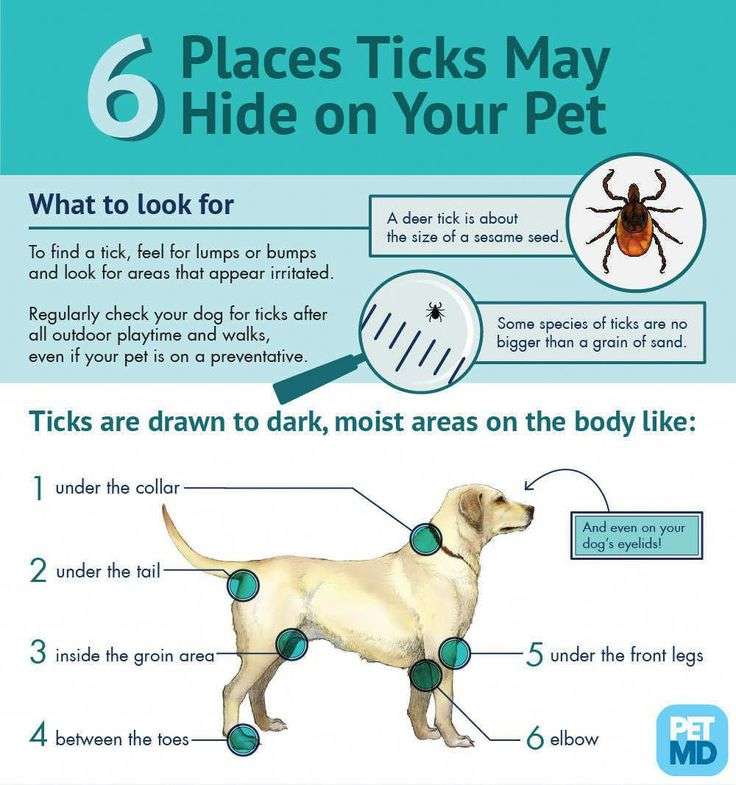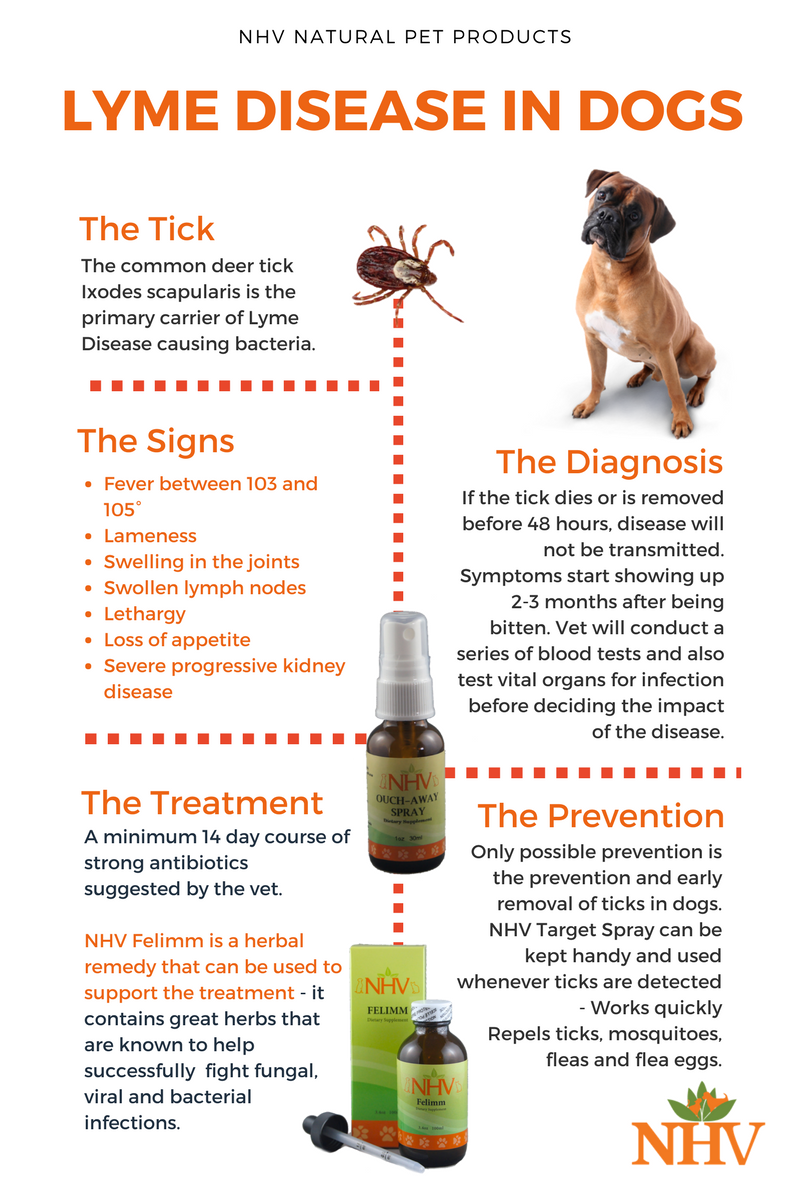Lyme Disease In Dogs: Prevention Symptoms And Treatment
August 20, 2018
With ticks and other disease-spreading insects proliferating throughout the United States, dog parents today are increasingly concerned about protecting themselves and their pups from Lyme disease. Lyme disease is commonly transmitted to dogs and humans through bites from blacklegged ticks and can cause serious symptoms and illness.
We partnered with the Cynthia Lopez, editor of Pet Life Today, on this important topic. Here is everything you need to know about Lyme Disease in dogs including preventative care, symptoms, and treatment options.
What is Lyme Disease?
Lyme disease, or borreliosis, is a potentially life-threatening inflammatory disease. It is caused by a microscopic organism that lives in the gut of deer ticks, also known as the Eastern blacklegged ticks and Western blacklegged ticks . Lyme disease is the most common tick-borne disease in the United States.
In addition to causing serious illness in dogs, Lyme disease can be transmitted to humans through bites from infected blacklegged ticks. It is important to keep in mind that just because you or your dog were bitten by a tick does not mean that you will automatically get Lyme disease. Even so, make sure you or your pets get tested if you do identify a bite from a blacklegged tick.
Ticks are on the Rise
If you live in an area likely to have a large tick population, you should take precautions to prevent your dog from getting Lyme disease. But is vaccination the way to go?
Summary Of Lyme Disease In Dogs
Lyme disease is transmitted via tick bites, and can cause lameness, swollen joints and even kidney failure. While it can be treated if the case is not too severe, prevention is best. The best way to prevent an infection is to reduce your dogs exposure to ticks and stay up-to-date on monthly preventatives and Lyme vaccinations.
What Exactly Is Lyme Disease
Lyme disease, or Borreliosis, is a very infectious disease in dogs that comes from exposure to ticks. It has many dominant symptoms that you can quickly notice in your dog, mainly lameness in the joins. Its one of the most common tick-transmitted diseases, but despite that, it still only causes symptoms in 5-10% of affected dogs. The ticks get into the dogs bloodstream through a bite and once in the bloodstream, the bacteria travels to different parts of the body and cause stiffness in specific joints and overall illnesses.
When a dog has Lyme disease, it suffers from inflammation in the joints, which means recurring lameness. This is a horrible sensation for dogs to feel and alongside it, they can also suffer from loss of appetite and depression, just to name a few. You dont want your furry friends to suffer from Lyme disease since its a very uncomfortable disease that can escalate into something fast, so its good to spot any red flags as early as possible.
When not detected on time, complications can arise from Lyme disease such as kidney problems, heart diseases, and nervous system failures. These are very rare but Labrador Retrievers, Golden Retrievers, Shetland Sheepdogs, or Bernese Mountain Dogs are unfortunately more at risk for kidney-related problems caused by Lyme disease.
Recommended Reading: How To Test Ticks For Lyme Disease
How Is Lyme Disease Treated In Dogs
Breathe easy: if caught in time, Lyme disease can be easily treated in dogs. The treatment includes antibiotics for a duration of usually for at least 30 days, as well as supportive medication if needed, Dr. Muller tells us. In order of use, those antibiotics are typically doxycycline, amoxicillin, followed by azithromycin. At times, dogs may need longer durations or more rounds of antibiotic treatments. Depending on how long they were ill, your pooch may also need therapy and treatments for individual organs or systems that have been affected by Lyme, especially the heart, nerves, joints, and kidneys.
How Is Lyme Disease Transmitted To Dogs

The bacterium Borrelia burgdorferi, which causes Lyme disease in dogs, is transmitted by a tick of the genus ixodes ricinus. When ixodes ricinus ticks attach themselves to the dogs coat, they feed on the dogs blood and transmit the bacteria.
For contamination to occur, the tick must be attached to the dogs skin for at least 48 hours. It is therefore not possible to see the tick because it is small. It will be more visible when it is full of blood.
Dogs at risk are those that are often outdoors, especially in wooded areas.
Also Check: How Fast Does Lyme Disease Show Up
How To Prevent Dogs From Having Ticks
While it is healthy to bring your dog out often to play, keeping them indoors most of the time is still the best way to avoid ticks. After a fun walk outside, thoroughly check them for any signs of ticks or itching as the longer a tick stays attached to your dog, the higher risk of developing a disease.
Ticks attach to grass, shrubs, etc. and latch on to nearby animals so it would be best to maintain a clean environment to avoid harboring ticks.
Diagnosing And Treating Your Dog
Diagnosing your dog for Lyme disease requires the veterinarian to run an antibody test. This test takes a closer look at the bodys immunity. The response of the immune system is measurable by the test.
The experts can see whether the antibody for Lyme disease is present for making a correct diagnosis. This will show that the dogs body has been fighting the disease. If the blood reports show a high volume of antibodies then your veterinarian can make a diagnosis. Once the experts confirm the presence of the infection, they will then start the treatment.
Fortunately, the treatment of Lyme disease is straightforward and includes taking antibiotics and painkillers. Unfortunately, there is no vaccine available. Scientists continue to work on developing a vaccine to prevent Lyme disease.
Also Check: Do Ticks In Florida Carry Lyme Disease
Prevention Of Lyme Disease
|
The diagnosis of Lyme disease is often based on the signs and history. For example, a veterinarian might suspect Lyme disease in a dog with recent lameness, a mild fever, and a history that includes possible exposure to ticks. Standard blood studies are not very helpful in diagnosis because the results tend to fall within normal ranges despite signs of infection. However, these tests may be important in order to rule out other causes of disease. Antibodies against the disease-causing bacteria can often be detected 4 to 6 weeks after the initial infection and help confirm the diagnosis.
What Are The Signs Of Lyme Disease In Dogs
Lyme disease in dogs is relatively common, but the symptoms are often confused with other illnesses or are so subtle they are not recognized at all. Its much more difficult to know when exposure has occurred in dogs than with humans because dogs dont develop a rash as humans do. Symptoms of canine Lyme disease can include the following.
- Loss of appetite
- Generalized pain
- Limping or lameness
Many pet parents seek out veterinary services due to these generalized symptoms with no idea that the cause could be Lyme disease. The side effects of Lyme disease in dogs can even come and go. Your dog may appear to recover, only to begin limping and losing their appetite again weeks or months later. Thats why you should never ignore symptoms like these in your pet.
You May Like: Do I Have Ms Or Lyme Disease
Anorexia And Digestive Tract Upset
Lyme disease causes anorexia, which can manifest as a decreased appetite to the degree that substantially less food is consumed, or all meals or treats may be completely refused.
Anorexia can be caused by hyperthermia , arthritis , myalgia , renal failure, or other ailments associated with infection by Borrelia burgdorferi.
Besides eating less or refusing food, dogs infected with Lyme disease can have other digestive tract upset such as emesis or diarrhea related to hyperthermia, renal failure, or other health problems.
Image:Monika Wisniewska/Shutterstock
Treatment Of Lyme Disease In Dogs
Four weeks of Doxycycline is the most common course used to treat Lyme and other tick-borne diseases . If dogs have been showing clinical signs, they often perk up and improve in a matter of days, but its important to give the full course of treatment. If dogs arent treated, or treatment has been delayed due to unknown diagnosis or other complications, they may continue to have issues for life
If specific organs are affected, more involved testing may be performed, and other treatments prescribed by your vet.
Recommended Reading: Nad Iv Therapy For Lyme Disease
Can You Prevent Lyme Disease In Dogs
The best way to prevent Lyme disease in your dog is by protecting them against infected ticks.
Adequate flea and tick prevention is essential in preventing tick-borne illness, as an approved tick repellent will prevent the tick from attaching long enough to spread disease.
You can speak with your vet about which tick prevention is best for your furry friend at your next wellness exam.
Not only is flea and tick prevention essential in preventing tick-borne illness, but so is avoidance of areas that are known to harbor a large amount of ticks.
Some of the most high risk areas include any regions with tall foliage, as this is the easiest way for a tick to come in contact with your dogs fur.
Not only should you avoid these areas when possible, but you should always search your dogs fur for any ticks after your outdoor adventures.
If you live in an area with a high rate of Lyme disease infections, you can speak with your veterinarian about the Lyme disease vaccine for dogs.
The vaccine is not 100% effective, meaning its important to have your dog on tick prevention in addition to administering the vaccine.
Kidney Damage Caused By Lyme Disease

More serious complications, although uncommon, include:
-
Damage to the kidneys
-
Rarely, heart or nervous system disease 1,2
Lyme disease sometimes leads to glomerulonephritisthe inflammation and accompanying dysfunction of the kidney’s glomeruli .
Eventually, kidney failure may set in as the dog begins to exhibit signs such as vomiting, diarrhea, lack of appetite, weight loss, increased urination and thirst, and abnormal fluid buildups that can appear as swollen limbs.
Recommended Reading: Cat’s Claw And Lyme Disease
Which Antibodies Does The Vaccine From Merial Induce
It is a recombinant vaccine based on Osp A. Vaccinated animals should develop high antibody levels to OspA and maintain negative antibody levels to the remaining two antigens. Infected/non-infected animals can be identified based on OspC and OspF antibody values. Detection of the early Lyme infection stage is possible after using this vaccine.
How Long After A Tick Bite Will Dogs Get Sick
If an infected tick has been on your dogs body for 24-48 hours, they have the ability to spread Lyme disease to your pup.
Once the bacteria makes its way into your dogs bloodstream, the clinical signs typically develop anywhere from 2-5 months after infection.
Some dogs have been known to develop symptoms years after their tick bite, proving just how varied this disease can be.
Not only can it take months for symptoms of Lyme disease to develop in dogs, but the clinical signs can come and go if the disease is left untreated.
For example, a dogs limp may disappear suddenly, only to return months later with a vengeance.
Also Check: How Long Does It Take To Get Lyme Disease
Treatment And Prevention Of Lyme Disease In Dogs
The treatment of Lyme disease aims at fighting the bacteria and joint inflammation.
The veterinarian may consider prescribing antibiotics and anti-inflammatory drugs in this case. Symptomatic treatment depends on the variety of clinical symptoms caused by the disease.
To avoid any risk of contamination, it is important to take preventive measures against tick bites. Indeed, there is a vaccine with an annual booster that reduces the risk, especially for dogs exposed to wooded and forested areas.
In addition, there are various anti tick products on the market, although they are not 100% effective. It is therefore recommended to check your dog for ticks, especially after a walk.
Canine Lyme Disease Signs And Symptoms
The symptoms of Dogs Lyme disease can be difficult to diagnose in the early stages. There are numerous commonalities among the early symptoms of dogs Lyme disease that may help in diagnosing the disease. However, most of these symptoms will need to be treated by a veterinarian.
Dogs with Lyme disease are not contagious and cannot spread the disease to humans. They cannot be treated for the disease, although antibiotics are available for those whose symptoms do not improve after two weeks. Some dogs, however, respond very well to this treatment.
Read Also: Red Light Therapy For Lyme Disease
Transmission Of Lyme Disease
Ticks that carry Lyme disease are often found in tall-grasses, thick bushes, marshes, and in the woods, especially in the Northeast, upper Midwest, and Pacific coast. So if you and your dog happen to be around terrain similar to that, be on the lookout! Ticks are waiting to get your dog when he walks by, so its best to be careful in areas like this or better yet, stay away from them. The whole process is extremely fast. In fact, once a tick lands on the dog and bites him, it can transmit the disease in less than 48 hours.
Blacklegged ticks are the primary carriers of Lyme disease. Blacklegged ticks are most commonly found in wooded and deep bushy, grassy areas, especially near the woods. Its hard to avoid ticks because ticks are a year-long problem and not specific to any season, but the majority of cases occur from October to March, so its important to keep that in mind when going outdoors with your dog. Ticks are crawlers that latch on to your dog by hanging out at the tips of bushes and grass and then jump onto your dogs skin.
Ticks are not exclusive to woods, though. Even city dogs can come in contact with ticks that carry Lyme disease. Ticks cant be dehydrated, so you wont find them in low-cut lawns out in the open.
Once you see the tick, its tempting to immediately take it off the dog with your fingers. But this is not recommended. Instead, get a pair of sharpened tweezers and grab them from the head as far down as possible.
Does Treatment Immediately After A Tick Bite Negate Signs Of Early Infection
Not every tick carries B. burgdorferi. The infection rate of ticks also varies with geographic region. Therefore, treatment should not be performed based on a tick bite alone. If the tick was found on the animal it can be sent in for B. burgdorferi PCR. PCR for Anaplasma can be performed simultaneously if requested. If the tick was infected, early treatment can be considered. However, a tick must feed for at least 24 hours on an animal or human for B. burgdorferi transmission to occur. Only a serological test will confirm whether transmission of B. burgdorferi occurred and the animal was infected. Antibodies can be detected in infected animals as early as 3-4 weeks after infection. Lyme Multiplex testing is recommended after that time. Treatment can be initiated immediately afterwards if antibody levels are positive. Treatment during this early infection phase is generally very effective.
Recommended Reading: Symptoms Of Untreated Lyme Disease
Treatment Of Lyme Disease
Lyme disease symptoms in dogs are treated with tetracycline or penicillin-based antibiotics. Most dogs recover in about two weeks, but in some cases antibiotics must be administered for thirty days or longer. Some dogs experience a recurrence of Lyme disease symptoms within a few weeks or months of finishing treatment. These dogs will need to undergo the treatment program again.
For Animals That Have Not Been Vaccinated Can Osp A Values Be Positive How Should This Be Interpreted

Antibodies to OspA have previously been interpreted as markers for vaccination. Non-vaccinated animals usually have low values for antibodies to OspA, while vaccinated animals develop these antibodies. OspA antibodies have been shown to protect from infection with B. burgdorferi.
However, there is accumulating evidence that antibodies to OspA can occur without vaccination. First, residual OspA is present on the bacterial surface at the time of transmission to an animal. This causes a low and transient OspA antibody response early after infection. Second, antibodies to OspA have also been associated with treatment-resistant Lyme arthritis and with development of autoimmunity in human patients. Similarly, OspA antibodies in non-vaccinated dogs or horses can be considered as markers of chronicity and disease severity.
Recommended Reading: How To Treat Chronic Lyme
What Is A Tick
- A tick is a parasite that is 3 to 5 mm in size. They are so small that it can be hard to spot them immediately.
- They are the most common trouble for pets, especially the ones that roam outside more often.
- They feed on animals blood. Often time they go unnoticed because of their small size and painless bites.
- There are also different types of ticks. A deer tick is a common kind in the United States.